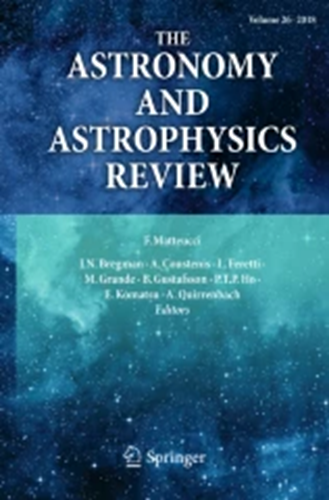初始质量函数对银河化学富集的影响
IF 26.5
1区 物理与天体物理
Q1 ASTRONOMY & ASTROPHYSICS
引用次数: 4
摘要
上下文。越来越多的证据表明,恒星初始质量函数(IMF)可能远远超出规范的Mi ~ 100M限制,但这种假设对星系化学富集的影响仍有待澄清。目标我们的目标是通过分析观测到的银河系中薄盘和厚盘恒星的丰度来解决这个问题,化学演化模型解释了非常大质量恒星作为对不稳定超新星死亡的贡献。方法。通过结合从流体静力学恒星演化模型中提取的风抛射物和文献中的爆炸抛射物,我们建立了新的大质量和超大质量恒星的化学产量集,最高可达Mi ~ 350M。我们使用一个简单的化学演化代码,通过将预测结果与太阳附近恒星的观测结果进行比较,来分析采用不同产量表的效果。结果。经过几次测试,我们把重点放在了能最好地分离两种银河系成分的化学模式的[O/Fe]比率上。我们发现,使用截断在Mi ~ 100M的标准IMF,我们可以重现薄盘恒星的各种观测约束,但同样的IMF无法解释厚盘恒星的[O/Fe]比率。最好的结果是将IMF扩展到Mi = 350M,并包括非常大质量恒星的化学喷射物,以风和对不稳定超新星爆炸的形式。结论。我们的研究表明,PISN可能在形成银河系厚盘的化学演化过程中发挥了重要作用。通过计算它们的化学产率,不仅可以更容易地再现α-增强的水平,还可以更容易地再现[O/Fe] vs. [Fe/H]图中观测到的厚盘星的斜率。最重要的是,非常大质量的恒星对星系的化学富集的贡献可能是相当重要的,在化学演化模型中不应该被忽视。本文章由计算机程序翻译,如有差异,请以英文原文为准。
The effects of the initial mass function on Galactic chemical enrichment
Context. There is mounting evidence that the stellar initial mass function (IMF) could extend much beyond the canonical Mi ∼ 100M limit, but the impact of such hypothesis on the chemical enrichment of galaxies still remains to be clarified. Aims. We aim to address this question by analysing the observed abundances of thinand thick-disc stars in the Milky Way with chemical evolution models that account for the contribution of very massive stars dying as pair instability supernovae. Methods. We built new sets of chemical yields from massive and very massive stars up to Mi ∼ 350M , by combining the wind ejecta extracted from our hydrostatic stellar evolution models with explosion ejecta from the literature. Using a simple chemical evolution code we analyse the effects of adopting different yield tables by comparing predictions against observations of stars in the solar vicinity. Results. After several tests, we focus on the [O/Fe] ratio which best separates the chemical patterns of the two Milky Way components. We find that with a standard IMF, truncated at Mi ∼ 100M , we can reproduce various observational constraints for thin-disc stars, but the same IMF fails to account for the [O/Fe] ratios of thick-disc stars. The best results are obtained by extending the IMF up to Mi = 350M and including the chemical ejecta of very massive stars, in the form of winds and pair instability supernova explosions. Conclusions. Our study indicates that PISN could have played a significant role in shaping the chemical evolution of the Milky Way thick disc. By including their chemical yields it is easier to reproduce not only the level of the α-enhancement but also the observed slope of thick-disc stars in the [O/Fe] vs. [Fe/H] diagram. The bottom line is that the contribution of very massive stars to the chemical enrichment of galaxies is potentially quite important and should not be neglected in chemical evolution models.
求助全文
通过发布文献求助,成功后即可免费获取论文全文。
去求助
来源期刊

The Astronomy and Astrophysics Review
地学天文-天文与天体物理
CiteScore
45.00
自引率
0.80%
发文量
7
期刊介绍:
The Astronomy and Astrophysics Review is a journal that covers all areas of astronomy and astrophysics. It includes subjects related to other fields such as laboratory or particle physics, cosmic ray physics, studies in the solar system, astrobiology, instrumentation, and computational and statistical methods with specific astronomical applications. The frequency of review articles depends on the level of activity in different areas. The journal focuses on publishing review articles that are scientifically rigorous and easily comprehensible. These articles serve as a valuable resource for scientists, students, researchers, and lecturers who want to explore new or unfamiliar fields. The journal is abstracted and indexed in various databases including the Astrophysics Data System (ADS), BFI List, CNKI, CNPIEC, Current Contents/Physical, Chemical and Earth Sciences, Dimensions, EBSCO Academic Search, EI Compendex, Japanese Science and Technology, and more.
 求助内容:
求助内容: 应助结果提醒方式:
应助结果提醒方式:


